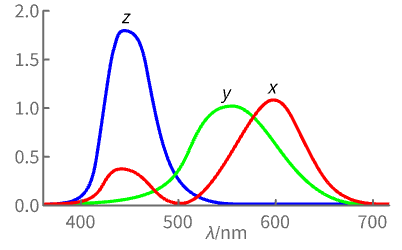

XYZColor
Details



- XYZColor is a color space defined in terms of standard responses to a power spectrum. It was the first standard quantitative color space and allows for objective comparison of colors.
- XYZColor is device independent and corresponds to the CIE 1931
 color space.
color space. - ColorConvert can be used to convert XYZColor to other color spaces.
- The parameters are defined as:
-
x 
color, combination of green and red y 
approximate luminance z 
color, approximately blue - The functions
 ,
,  and
and  are the CIE standard human observer color-matching functions,
are the CIE standard human observer color-matching functions,  is the spectral power distribution, and
is the spectral power distribution, and  is the wavelength in nanometers.
is the wavelength in nanometers. - XYZColor allows any non-negative real number for x, y, and z; negative values will be clipped.
- RGBColor approximately corresponds to x between 0 and 0.97, y between 0 and 1, and z between 0 and 0.83.
- If no opacity has been specified, XYZColor[x,y,z] is equivalent to XYZColor[x,y,z,1].
- XYZColor[x,y,z,a] is equivalent to {XYZColor[x,y,z],Opacity[a]}.
- The alternative forms XYZColor[{x,y,z}] and XYZColor[{x,y,z,a}] can also be used. »
- {XYZColor[…], p1, …} indicates that graphics primitives pi should be displayed in the color given.
- The following wrappers can be used around colors:
-
ColorsNear[color,…] specifies a region around color Directive[…,color,…] specifies a color in combination with other directives » Glow[XYZColor[…]] specifies color independent of lighting » Opacity[a,color] specifies a color with an opacity a Style[expr,XYZColor[…]] displays expr with the specified color » - For 3D surfaces, explicit XYZColor directives define surface colors; the final shading depends on lighting and contributions from specularity and glow. »


Examples
open all close allBasic Examples (4)
Scope (3)
Generalizations & Extensions (2)
Tech Notes
Related Guides
Text
Wolfram Research (2014), XYZColor, Wolfram Language function, https://reference.wolfram.com/language/ref/XYZColor.html (updated 2021).
CMS
Wolfram Language. 2014. "XYZColor." Wolfram Language & System Documentation Center. Wolfram Research. Last Modified 2021. https://reference.wolfram.com/language/ref/XYZColor.html.
APA
Wolfram Language. (2014). XYZColor. Wolfram Language & System Documentation Center. Retrieved from https://reference.wolfram.com/language/ref/XYZColor.html
BibTeX
@misc{reference.wolfram_2025_xyzcolor, author="Wolfram Research", title="{XYZColor}", year="2021", howpublished="\url{https://reference.wolfram.com/language/ref/XYZColor.html}", note=[Accessed: 12-December-2025]}
BibLaTeX
@online{reference.wolfram_2025_xyzcolor, organization={Wolfram Research}, title={XYZColor}, year={2021}, url={https://reference.wolfram.com/language/ref/XYZColor.html}, note=[Accessed: 12-December-2025]}